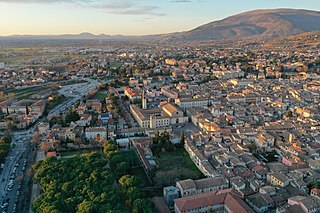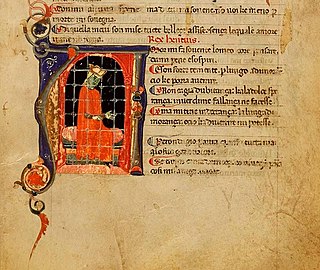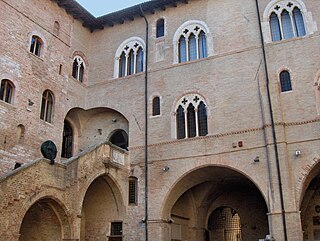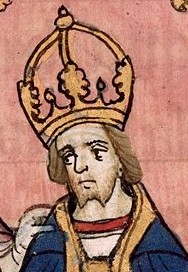
The Trinci were a noble family from central Italy, who were lords of Foligno, in Umbria, from 1305 to 1439.

The Trinci were a noble family from central Italy, who were lords of Foligno, in Umbria, from 1305 to 1439.
During the War of the Guelphs and Ghibellines which tore apart Italy from the 12th to the 14th century, the Trinci were initially Guelphs, but switched to the other party from 1240. Corrado (I) and Trincia I Trinci held the title of podestà or vicar of Foligno in the late 13th century.
In 1305 the Trinci, after returning to the Guelphs, became lords of Foligno by expelling the Ghibelline Anastasi thanks to the support of nobles from Spoleto and Perugia. Nallo governed as capitano del popolo until 1321. After him, the Trinci held the titles of gonfaloniere di giustizia and capitani.
Nallo's brother, Ugolino, ruled until 1338, being succeeded by Nallo's son, Corrado I, who died in 1343. He was followed by Ugolino Novello, the last to hold the aforementioned titles. The first official recognition came in 1367, when Pope Urban V named Ugolino's son, Trincia II Trinci, as apostolic vicar. Trincia was killed in 1377 by some Ghibellin exiles. His brother Corrado II ruled Foligno until 1388, followed by his son Ugolino III, who was a friend of the condottiero Braccio Fortebraccio.
His sons Niccolò, Bartolomeo and Corrado III co-ruled the city from 1415 to 1421. Corrado, however, decided to break with the Papal authority. Assailed by Cardinal Giovanni Maria Vitelleschi, he lost Foligno, which thereafter lost its autonomy and became part of the Papal States.

The Guelphs and Ghibellines were factions supporting respectively the Pope and the Holy Roman Emperor in the Italian city-states of Central Italy and Northern Italy during the Middle Ages.
Ugolino is an Italian masculine given name that is a diminutive form of Ugo. It may also refer to:

The House of Montefeltro is the name of a historical Italian family who ruled Urbino and Gubbio and became Dukes of Urbino in 1443. The family extinguished in the male line in 1508 and the duchy was inherited by the Della Rovere family.

Foligno is an ancient town of Italy in the province of Perugia in east central Umbria, on the Topino river where it leaves the Apennines and enters the wide plain of the Clitunno river system. It is located 40 kilometres south-east of Perugia, 10 km (6 mi) north-north-west of Trevi and 6 km (4 mi) south of Spello.

The House of Malatesta was an Italian family that ruled over Rimini from 1295 until 1500, as well as other lands and towns in Romagna and holding high positions in the government of cities in present-day Tuscany, Lombardy and Marche. The dynasty is considered among the most important and influential of the Late Middle Ages. In the period of maximum influence, they extended their domains along the Marche coast, up to Ascoli Piceno, Senigallia, Sansepolcro and Citerna, and to the north, on the territories of Bergamo and Brescia.

Enzo was an illegitimate son of the Hohenstaufen emperor Frederick II, who appointed him 'King of Sardinia' in 1238. He played a major role in the wars between Guelphs and Ghibellines in the Imperial kingdom of Italy, and was captured by his enemies in 1249. He remained imprisoned in Bologna until his death.
The siege of Faenza occurred from August 1240 to April 14, 1241, during the course of the wars of the Guelphs and the Ghibellines. In this military confrontation, the Holy Roman Emperor Frederick II aggressively laid siege to the town of Faenza and successfully captured the city.

The House of Monaldeschi was one of the powerful noble families of Orvieto, central Italy, members of the Guelph party who contested with murders and violence the Ghibelline Filippeschi for control of the commune of Orvieto and the castelli of Umbria.
Malatesta II Malatesta, best known as Guastafamiglia was an Italian condottiero and lord of Rimini.
William VII, called the Great Marquis, was the twelfth Marquis of Montferrat from 1253 to his death. He was also the titular King of Thessalonica.
Corrado IIITrinci was lord of Foligno from 1421 until 1439.
Ugolino III Trinci was Lord of Foligno in the early 15th century.
Niccolò I Trinci was the lord of Foligno from 1412, inheriting it from his father Ugolino III Trinci. He also fought as condottiero for the Republic of Venice. In 1404, he married Tora da Varano, daughter of Rodolfo III da Varano, lord of Camerino.
Bartolomeo Trinci was the lord of Foligno from 1415. He succeeded his father Ugolino III Trinci, jointly with his brothers Niccolò and Corrado.
Corrado IITrinci was the lord of Foligno from 1377 until his death. He was the son of Ugolino II Trinci.
Ugolino II Trinci was the lord of Foligno from 1343 until his death. He was the son of Nallo I Trinci and succeeded his brother Corrado I in the lordship in 1343.

The Trinci Palace is a patrician residence in the center of Foligno, central Italy. It houses an archaeological museum, the city's picture gallery, a multimedia museum of Tournaments and Jousts and the Civic Museum.
Trincia IITrinci was lord of Foligno, in central Italy, from 1353; he was the son of Ugolino Novello Trinci.

Henry VII, also known as Henry of Luxembourg, was Count of Luxembourg, King of Germany from 1308 and Holy Roman Emperor from 1312. He was the first emperor of the House of Luxembourg. During his brief career he reinvigorated the imperial cause in Italy, which was racked with the partisan struggles between the divided Guelph and Ghibelline factions, and inspired the praise of Dino Compagni and Dante Alighieri. He was the first emperor since the death of Frederick II in 1250, ending the Great Interregnum of the Holy Roman Empire; however, his premature death threatened to undo his life's work. His son, John of Bohemia, failed to be elected as his successor, and there was briefly another anti-king, Frederick the Fair, contesting the rule of Louis IV.
Conrad of Antioch was a scion of an illegitimate branch of the imperial Staufer dynasty and a nobleman of the Kingdom of Sicily. He was the eldest son of Frederick of Antioch, imperial vicar of Tuscany, and Margherita di Poli. He was thus a grandson of the Emperor Frederick II, a nephew of King Manfred of Sicily (1258–66) and cousin of King Conradin (1266–68). His surname, which is contemporary, comes from his paternal grandmother, a mistress of Frederick II from Antioch. He may be called "Conrad I" to distinguish him from his descendants with the same given name.